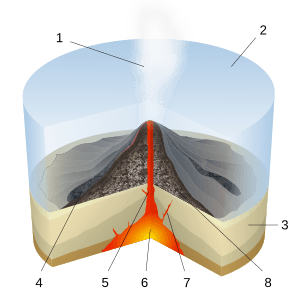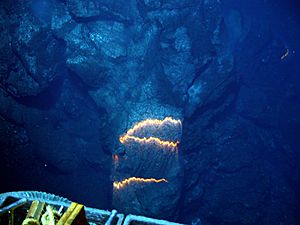Submarine volcano facts for kids

Submarine volcanoes are amazing openings or cracks in the Earth's surface found deep underwater. Hot magma can burst out from these spots.
Many submarine volcanoes are located where Earth's giant tectonic plates are forming new crust. These areas are called mid-ocean ridges. Scientists believe that volcanoes along these ridges create about 75% of all the magma that comes out on Earth!
Most submarine volcanoes are in the deep parts of oceans. But some are in shallow water. These shallow ones can even shoot material into the air during an eruption. There are over a million submarine volcanoes in total, but most are no longer active. Only 119 have erupted in the last 11,700 years.
You can often find Hydrothermal vents near submarine volcanoes. These vents are like hot springs on the seafloor and are full of unique life forms.
Contents
How Water Changes Volcanoes
Water plays a huge role in how a volcano erupts. Underwater eruptions are very different from those on land.
For example, water makes magma cool down super fast. This often turns the lava into a type of volcanic glass. The shapes of lava formed underwater are also special. When hot lava touches cold water, a solid crust forms around it. More lava then flows into this crust, creating rounded shapes called pillow lava. They look like giant pillows stacked on top of each other!
In very deep parts of the ocean, about 2200 meters down, the water pressure is incredibly high. At this depth, water cannot boil like it does on the surface. It turns into a special kind of fluid. This means deep-sea volcanoes don't make boiling sounds. This makes them harder to find using special underwater microphones called hydrophones.
Exploring Underwater Volcanoes
Scientists are still learning a lot about where underwater volcanoes are and how active they are. In recent years, groups like NOAA's Office of Ocean Exploration have funded missions to explore these hidden wonders.
One famous mission was to the Mariana Arc in the Pacific Ocean. Using special underwater robots called Remote Operated Vehicles (ROVs), scientists studied eruptions. They found pools of melted sulfur, tall chimneys called black smokers, and amazing sea creatures that live in these hot, deep places.
In 2019, people saw a huge raft of pumice (lightweight volcanic rock) floating in the South Pacific. Scientists later found out it came from a nearby submarine volcano that had erupted. They even saw the volcanic plume (a cloud of gas and ash) in satellite images. Discoveries like this help scientists predict future eruptions.
What are Seamounts?
Many submarine volcanoes are also known as seamounts. These are usually extinct volcanoes that rise steeply from the seafloor. They are defined as features that rise at least 1,000 meters (about 3,300 feet) above the ocean floor.
Seamounts are often found hundreds or thousands of meters below the ocean surface. This means they are part of the deep sea. Scientists estimate there are about 30,000 seamounts around the world, but only a few have been studied closely.
Some seamounts are quite unusual. For example, the Bowie Seamount off the coast of Canada rises from a depth of 3,000 meters to within just 24 meters of the sea surface!
Listening to Eruptions
Scientists can learn about submarine eruptions by listening to the sounds they make. There are two main types of sounds:
- One sound comes from large lava bubbles slowly releasing and bursting.
- The other sound comes from quick explosions of gas bubbles.
By telling these sounds apart, scientists can learn how eruptions affect marine animals and their homes. They can also estimate how much lava is flowing.
In 2009, researchers used a video camera and a hydrophone near the West Mata Volcano in the Pacific Ocean. They watched and listened as the volcano erupted. By putting the video and audio together, they learned the different sounds made by slow lava bursts and hundreds of gas bubbles.
See also
 In Spanish: Volcán submarino para niños
In Spanish: Volcán submarino para niños




